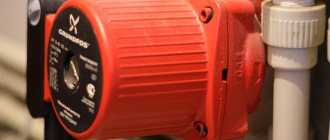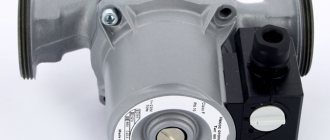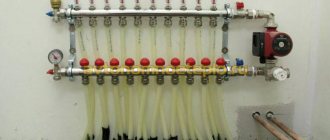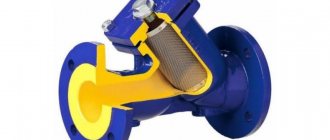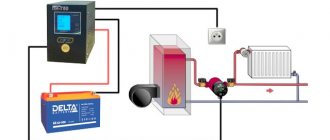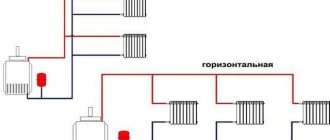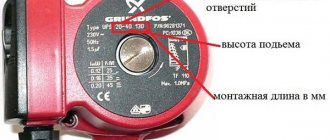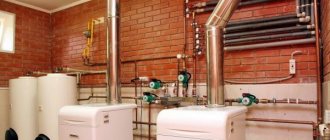pump for heating, first of all, you need to know the initial parameters of the heating system and the building in which it is installed.
Circulation pumps
NASOSOV.by
hypermarket catalog There are two types of heating systems: with forced and natural circulation of coolant in the system. When designing a heating system with forced circulation of coolant, the required pump power is calculated in advance. There are also old heating systems with metal pipes of large diameters, into which it would be quite appropriate to embed a pump to increase the circulation rate of the coolant, and, consequently, greater fuel savings due to unloading of the heat source. Thus, a system with forced circulation of coolant is more comfortable to operate, since it allows you to regulate the supplied heat, pipelines of a smaller diameter are used, and such a system looks more aesthetically pleasing.
In any case, the parameters by which the pump is selected are maximum flow and pressure (m3/hour and m, respectively). Also, the type of pump must be a circulation pump, designed for operation with high-temperature coolant (sometimes up to 110°C). And in order to make the heating system as safe as possible, it is recommended to buy a hydraulic separator.
For more accurate calculations, it is necessary to provide a graph of the pressure-flow characteristics of the heating system. In general it looks like this:
This graph reflects the interaction of the pressure-flow curves of the pump and the heating system. Without delving into hydrodynamics and physics, for a general understanding of how to choose a circulation pump, it is enough to understand the fact of the presence of resistance in heating systems. Any system has resistance to the movement of the coolant; it depends on the configuration, the diameter of the pipes, the presence of air in the system and other, less influential parameters. As a matter of fact, the pump is designed to overcome this resistance in order to ensure the circulation of working fluid in the system at a given speed. The intersection point of the curves on the graph shows the actual head loss and flow rate.
Thus, in order to choose the right circulation pump, you need to know two parameters of the heating system:
1. Heating system flow
2. The resistance it provides at a given flow rate.
Let's look at each parameter in more detail.
How to choose the right pump
Equipment installed in the heating system must comply with its operating characteristics. If the model is selected incorrectly, the room temperature will be uncomfortable - too high or too low.
The main selection parameters are:
- connection diameter. To determine it, it is enough to measure the pipes in the heating system. Standard connection diameters are 1” (25 mm) and 1¼” (32 mm);
- installation length. It is indicated in the marking of the circulation pump and can be 130 or 180 mm. Selected in accordance with the location and features of equipment installation;
- pressure To determine it, you need to know the total length of the heating circuit. For every 10 m of the system there should be about 0.6 m of head water column. If the circuit length does not exceed 80 m, one pump will usually be sufficient;
- equipment performance. It is calculated using the formula Q = N/(T2-T1). Q - productivity, N - power (kW), T2 - outlet temperature (+90...+95 oC) and T1 (+60...+70 oC) - at the boiler inlet.
Grundfos ups pump technical specifications
Technical characteristics of the grundfos UPS pump are presented in the catalog in the documentation section. Below we propose to consider a summary field of hydraulic characteristics.
We would like to give fairly banal advice that it is better to buy a Grundfos UPS pump in a specialized store from an official dealer. There are many fakes on the markets where Grundfos is easily confused with low-quality manufacturers. Counterfeits of Grundfos UPS pumps are indistinguishable to non-specialists, so be wise and do not fall for the tricks of scammers. The video highlights the typical differences between the original and the fake:
Grundfos not only takes care of promoting products on the market by expanding the dealer network, but also creates conditions for warranty support. When purchasing a Grundfos UPS pump, the buyer can always count on technical support.
Summing up
The Danes have set a high quality trend; the Grundfos pump has occupied the leading steps of the pedestal for many years. The scope of Grundfos equipment is extremely wide. Today we looked at a household pump UPS, installed to increase the flow rate of coolant and faster delivery of hot media to heating radiators.
However, do not forget about the optimal ratio of the coolant speed and the diameter of the pipeline system. High speed will cause a hum, insufficient speed will cause your household to freeze. If you are not sure that you can choose the right Grundfos pump, it is better to use the help of a specialist.
In addition, Grundfos pumping equipment is effectively used in organizing the supply of hot water. The Grundfos pump will become an indispensable tool in the installation of water-filled underfloor heating systems. Grundfos pumps can often be found as part of finished boiler equipment; BAXI gas boilers are a prime example. It is difficult to imagine the functioning of central air conditioning and ventilation systems without a Grundfos pump.
As a piece of advice, we would add that it is better to piping a double-circuit boiler using a Grundfos pump from the Alpha family. The demand for Grundfos Alpha pumps during installation of underfloor heating is growing significantly. The Grundfos UPS household series is less powerful; the circulation pump pushes the water column only 80 meters. For higher needs there is the Grundfos MAGNA 3 range.
Basic parameters of heating pumps
There are not many parameters that you should pay attention to when choosing a device. In fact, there are only two of them - pressure and productivity (flow)
Pressure is the hydraulic resistance of the system that the pump is able to overcome. This value is measured in meters of water column. As a rule, the hydraulic resistance of the entire system is set by the highest point of the pipeline through which water circulates.
The pump's performance, measured in m³/h, shows how much liquid it can move through the pipeline per unit of time. Therefore, before choosing the required model, you need to know the exact volume of coolant in the system.
Important! Pressure and productivity are inversely proportional to each other. That is, the maximum pressure is achieved at zero supply
And, conversely, the maximum flow rate is possible at zero pipeline height.
It is the pressure-flow characteristic of the device that allows us to determine the model with optimal parameters for a specific system. At the same time, the standard formula - the more powerful, the better - is not entirely suitable for this case. Because this means purchasing a more expensive unit and increasing energy consumption.
Putting the pump into operation
Before connecting, the device is filled with water and air is pumped out. To release air, a bolt located on the rear of the motor is rotated. The air will begin to bleed. If water begins to flow out, it means the air has been released. The bolt returns to its original position. The valves on the suction and discharge sides open.
To switch the speed, use a speed switch located on the capacitor box.
Installation rules
- Installation is carried out in a ventilated, warm room.
- Installation is carried out after completion of welding and cleaning of the system.
- Closing valves are mounted at the inlet and outlet to the pump; this will prevent leaks and water from draining from the system when repairing the unit.
- To prevent breakdowns, the device is installed above or near the pipes.
- The device is connected to the pipeline so that the axis of the incoming and outgoing pipes coincide.
- To ensure quiet operation and absence of vibration, the unit is not installed close to the knee.
- The diameter of the pipe must match the diameter of the unit;
- Installation is carried out so that the direction of the arrow on the device coincides with the direction of the working fluid;
- The unit is installed taking into account accessibility if necessary.
Safety precautions
Before dismantling or installing the unit, it is disconnected from the network. Before dismantling the device, wait until it cools down.
When bleeding air, electrical parts are protected. To avoid damage, the pump is installed in a dry place.
Characteristics and installation diagram of the Gilex Compass pump
The temperature range of the room is from minus ten to plus fifty degrees Celsius.
Problems with Gilex and how to fix them
Circulators are reliable, but minor problems occur. To eliminate them you need to know the cause.
List of problems:
- When starting, the unit stops immediately. The reason is plaque between the impeller and the housing. The problem can be resolved by removing the plaque and unlocking the shaft;
- high noise level. The reason is air in the system or high water pressure. Fix the problem by bleeding air from the system and reducing the fluid speed;
- the unit does not start. The reason is that there is no voltage in the network, the capacitor has broken, deposits on the bearings have blocked the shaft. It is necessary to check the integrity of the cable and unblock the shaft;
If the operating rules are followed, the compass will serve for many years and does not require repair work.
Gilex Compasses are distinguished by their reliability and quality. Positive reviews confirm the quality of the devices.
Grundfos UPS pump, selection. Selection table.
If we want to choose the right Grundfos UPS circulation pump, first we need to determine such characteristics as pressure = H in meters, and flow = Q in cubic meters. Then you need to calculate how much heat will be needed to heat your area.
To do this, a boiler with power is initially selected based on the parameters of the house. The calculation is not easy, you will need the dimensions of the area, you will have to take into account the number of radiators in the system, take into account the insulation of the house, decide on the installation of windows, ceiling heights, and so on and so forth. We advise that it is better to leave the calculations to specialists and experienced installers.
As a result of the calculations, we will obtain the required values; using them, based on the graphs of the hydraulic curves, we select the pump. But for simplicity, you can use the table for selecting pumps depending on the area of the house. In addition, as we know, the Grundfos UPS pump has three speeds, with which we will adjust the pump to our system.
| Heated area (m2) | Productivity (m3/hour) | Brands Grundfos UPS |
| 80 – 240 | From 0.5 to 2.5 | UPS 25 – 40 |
| 100 – 265 | From 0.5 to 2.5 | UPS 32 – 40 |
| 140 – 270 | From 0.5 to 2.7 | UPS 25 – 60 |
| 165 – 310 | From 0.5 to 2.7 | UPS 32 – 60 |
As can be seen from the table above, the owner of a two-story house with an area of 100-265 m2 is recommended to use a Grundfos UPS 32/40 or UPS 32/60 heating pump if he has water-heated floors. The decision to consult with your heating system installers is welcome; they know your system more accurately and, based on experience, will suggest the best size of Grundfos pump. You can also select a UPS pump based on the known boiler power according to the table below:
In this matter, the rule does not work - the more powerful the better, since an oversized pump in terms of hydraulic parameters, firstly, consumes more electricity, which leads to low energy efficiency. Secondly, the pipeline system may make noise, causing significant discomfort to your household. In the video, the legendary Grundfos UPS 25-40 180 pump.
Heating system flow
To determine the flow rate of the heating system, you need to know 3 parameters of the initial data:
1. The average temperature of the liquid in the heating system.
2. Temperature difference at two points of the system: the supply and return pipelines of the system.
3. The amount of heat consumed by the heating system (J, kW, calories).
The average coolant temperature is determined in each specific case. The lower it is, the less heat loss in the system.
The temperature difference in the supply pipeline and the return line is selected arbitrarily from the range from 5°C to 20°C. This difference further affects the speed of the coolant, and therefore the flow rate. By varying the choice of this value and knowing the specific diameter of the pipes, you can achieve maximum similarity between the characteristics of the pump and the system.
The amount of heat consumed by the system is calculated based on the following parameters:
- area of heated premises;
- number of floors of the building;
- type of building and building materials (old brick building, panel house, etc.);
In practice, they use the value for every 10 m2 of heated space, 1 kW of energy is required, supplied by the heating system. This is an average value; more accurate information can be obtained by using the services of a specialist or by looking at SNiP.
Common labeling
When choosing a Wilo brand pump, you should pay attention to the letter and number designations that come after the main part of the name. Each of the letter designations indicates the type of product, and the numbers in the product labeling indicate its most important characteristics.
Drain TMW 32/11
This Wilo pump model is a vortex drainer made from various materials. The device is capable of pumping slightly polluted water (meaning those in which the diameter of the pollution particles does not exceed 1 cm).
Brief technical characteristics of the circulation pump Vilo Drain TMW 32/11:
- The maximum depth at which it can be used is 3 m.
- This device has overheat protection. In 60 minutes of operation it will be able to pump 15 cubic meters. meters of water.
- As the name implies, the head height of this device is 11 m, cross-section is 165 mm.
Its average cost is 10,500 rubles.
